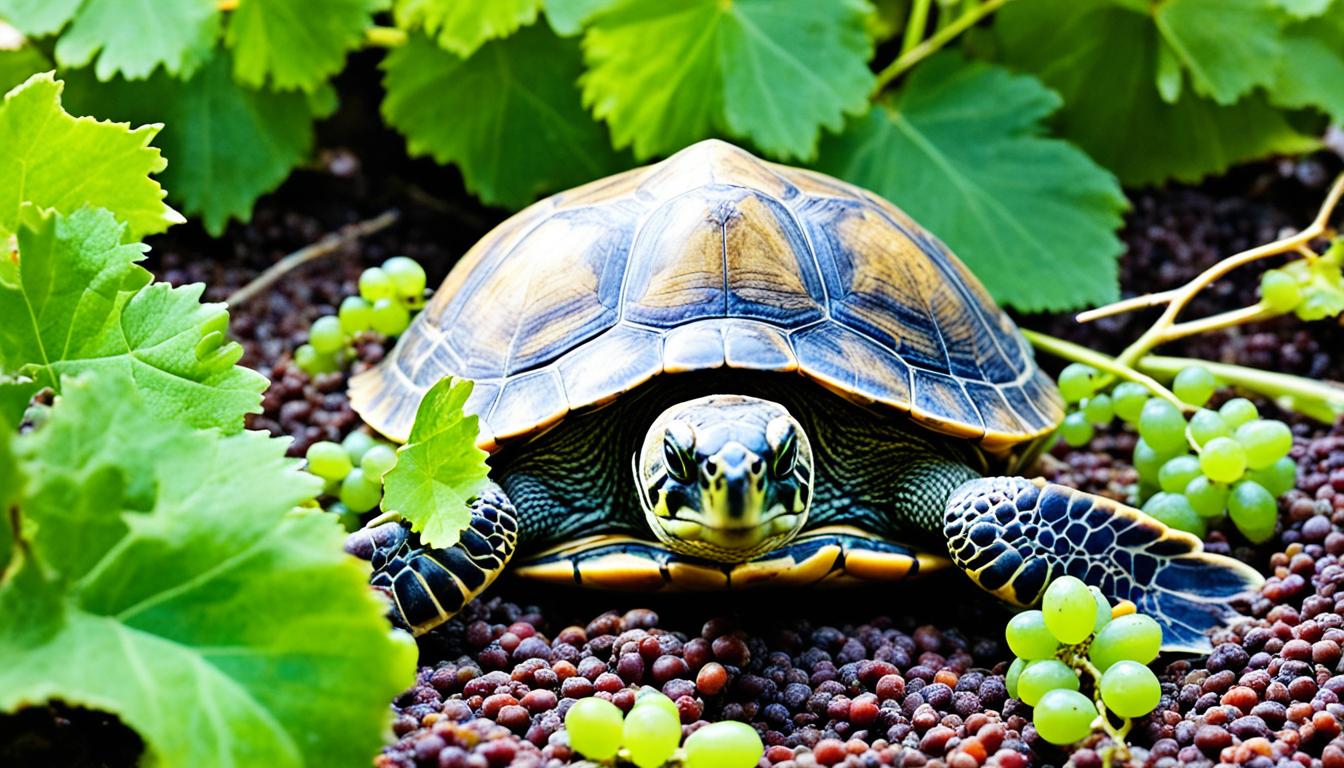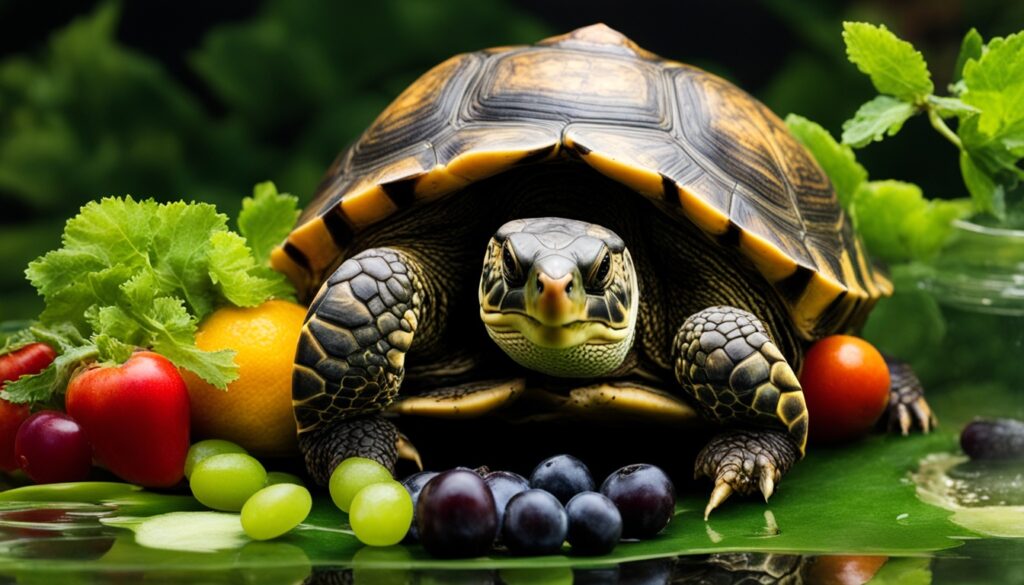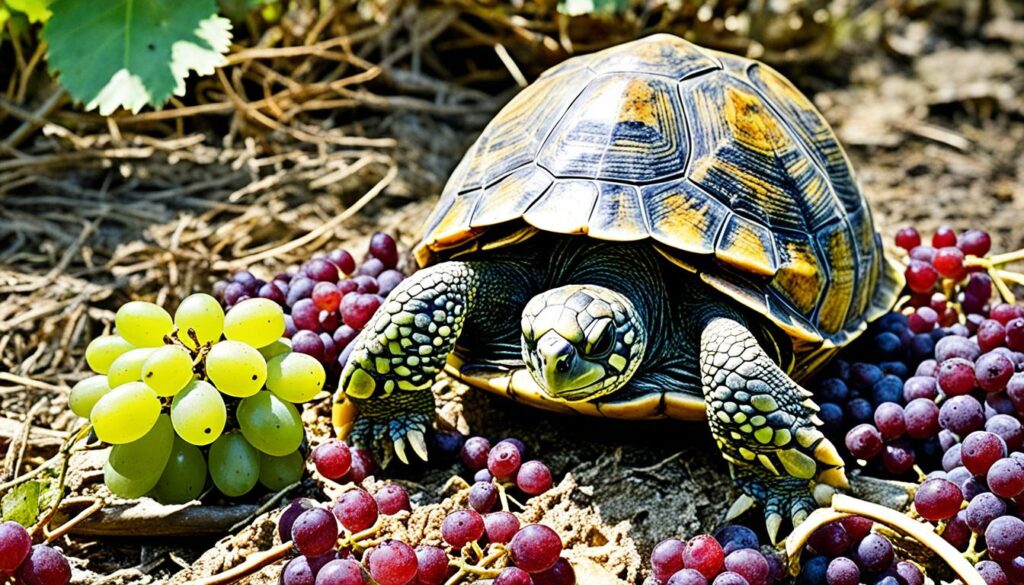Can Turtles Eat Grapes? A Guide for Pet Owners

As a curious pet owner, you may have pondered the question, “Can turtles eat grapes?” After all, grapes are a popular and nutritious fruit often enjoyed by humans. But when it comes to our shelled friends, the answer may not be as straightforward. In this comprehensive guide, we’ll explore the potential benefits and risks of feeding grapes to your pet turtle, ensuring your beloved reptile stays healthy and happy.
Key Takeaways
- Turtles can safely consume grapes in moderation as part of a balanced diet.
- Grapes provide hydration and some essential nutrients, but they are also high in sugar and should be fed with caution.
- Proper portion sizes and frequency are crucial to avoid digestive issues and other health problems in turtles.
- Certain turtle species, such as box turtles, can incorporate grapes into their diet more readily than others.
- Consulting with a veterinarian is recommended to ensure your turtle’s dietary needs are met.
Introduction to Grapes and Turtles
Turtles have unique dietary needs, and as pet owners, we often wonder about incorporating different foods into their meals. Grapes, being a popular fruit, have sparked curiosity among turtle enthusiasts. This section delves into the basics of turtle nutrition and the intriguing question of whether turtles can safely consume grapes.
Understanding Turtle Dietary Needs
Turtles are generally omnivorous, meaning they consume a balanced diet of plant and animal matter. According to statistical data, omnivorous turtles typically require a diet that consists of more than 50% plant material, around 25% pellets, and approximately 25% live animal protein. Variety in their diet is essential to avoid nutritional imbalance and illnesses.
Adult turtles should be offered food every two to three days, while juveniles usually eat on a daily basis. Treats for turtles should not exceed 5% of their overall diet, and vegetables should make up the majority of an adult omnivorous aquatic turtle’s diet. Live food, such as feeder fish, insects, and shellfish, is crucial for providing protein to turtles.
The Curiosity Around Feeding Grapes to Turtles
Fruits, including grapes, can be offered as an occasional treat for turtles, alongside other safe options like apples, berries, figs, mango, melon, and pears. However, it’s important to understand the role of grapes in a turtle’s overall nutritional needs and the potential risks associated with overfeeding them.
The curiosity around feeding grapes to turtles stems from their popularity as a human snack and the desire to provide a varied and enjoyable diet for our shelled companions. As pet owners, we want to ensure that any new food we introduce to our turtles is safe and beneficial for their health.
can turtles eat grapes
The Straight Answer
The short answer is yes, turtles can eat grapes. However, it’s important to understand the nutritional profile of grapes and how they can impact a turtle’s dietary needs.
Grape Nutrition for Turtles
Grapes are composed of over 80% water, making them a hydrating treat for turtles. They also contain beneficial nutrients such as:
- Calcium: Grapes contain approximately 10 mg of calcium per 100 grams, which is important for maintaining strong bones and shells in turtles.
- Phosphorus: Grapes have around 20 mg of phosphorus per 100 grams, contributing to overall shell health.
- Vitamin A: Grapes provide 66 IU of vitamin A per 100 grams, vital for eyesight and immune system function in turtles.
However, it’s worth noting that grapes also have a relatively high sugar content, which can potentially lead to digestive issues if consumed in excess.
| Nutrient | Amount per 100g |
|---|---|
| Water | 54g |
| Carbohydrates | 18.1g |
| Fat | 0.16g |
| Protein | 0.72g |
| Calcium | 10mg |
| Phosphorus | 20mg |
| Vitamin A | 66IU |
While some turtles, like ornate box turtles, can consume grapes as part of their diet, it’s essential to maintain portion control and ensure that grapes make up no more than 14-16% of their total food intake. For other turtle species, such as red-eared sliders, grapes should be offered only as an occasional treat due to their high sugar content.
Fitting Grapes into a Turtle’s Diet
Integrating grapes into a turtle’s diet requires careful consideration. While grapes can provide some beneficial nutrients, they should be fed in moderation as part of a balanced and nutritious diet for your pet turtle.
Fruits, including grapes, should make up only a small portion of a turtle’s overall diet, around 5-10%. The majority of a turtle’s diet should consist of nutrient-dense vegetables and protein sources. This ensures your turtle receives the appropriate balance of vitamins, minerals, and essential nutrients required for optimal health and growth.
When feeding grapes to your turtle, it’s best to introduce them slowly and in small portions. Grapes are high in sugar, which can lead to digestive issues if consumed in excess. Start with just a few grape slices or cubes and observe how your turtle reacts. If there are no adverse effects, you can gradually increase the amount, but be sure to keep grapes as an occasional treat rather than a dietary staple.
To ensure your turtle’s diet is well-rounded, consider incorporating a variety of other safe and healthy fruits, such as papaya, mango, watermelon, and figs. These can provide additional vitamins and minerals while adding some natural sweetness to your turtle’s meals.
| Fruit | Nutritional Benefits for Turtles | Recommended Portion |
|---|---|---|
| Grapes | Hydration, vitamins C and K | 14-16% of diet for land turtles, occasional treat for aquatic turtles |
| Papaya | Vitamins A and C | Occasional treat |
| Mango | Vitamins A and C | Occasional treat |
| Watermelon | Hydration, vitamins A and C | Occasional treat |
| Figs | Calcium-rich | Occasional treat |
Remember, the key to a healthy turtle diet is balance and variety. By incorporating grapes and other fruits in moderation, while focusing on nutrient-dense vegetables and protein sources, you can ensure your turtle thrives and enjoys a well-rounded, nutritious diet.

Potential Risks of Overfeeding Grapes
While turtles can safely consume grapes in moderation, overfeeding this fruit can lead to potential health risks. It’s important for pet owners to understand the potential consequences of excessive grape consumption to ensure their turtle’s well-being.
Stomach Upset and Diarrhea
Grapes are high in sugar, and consuming too many can disrupt a turtle’s delicate digestive system. Overfeeding grapes may result in stomach upset, diarrhea, and other gastrointestinal issues. These uncomfortable symptoms can lead to dehydration and nutrient imbalances if left unaddressed.
Calcium-Phosphorus Ratio Concerns
Turtles require a specific calcium-to-phosphorus ratio in their diet to maintain healthy bone development and overall well-being. Grapes are relatively low in calcium but high in phosphorus, which can throw off this critical balance if grapes make up a significant portion of the turtle’s diet. This imbalance may contribute to weakened bones, shell deformities, and other skeletal issues.
To avoid these potential risks, it’s essential to feed grapes to turtles in moderation and as an occasional treat, rather than a dietary staple. Consulting with a veterinarian can help pet owners create a balanced and nutritious meal plan that meets the specific needs of their turtle species.

“Overfeeding grapes can lead to a range of health problems for turtles, from digestive issues to imbalanced nutrition. It’s crucial to understand the potential risks and feed this fruit sparingly as a treat.”
Conclusion
In conclusion, turtles can enjoy grapes as an occasional treat, but it’s essential to understand the appropriate ways to incorporate this fruit into their diet. By being mindful of the nutritional profile of grapes and how they fit into a balanced caring for pet turtles, pet owners can ensure their shelled friends reap the benefits without risking their overall healthy turtle diet.
Grapes can provide turtles with a flavorful and hydrating addition to their feeding turtles treats, but they should be fed in moderation. Overindulgence in grapes can lead to digestive issues and imbalances in the vital reptile nutrition that turtles require. By following best practices and monitoring portion sizes, turtle enthusiasts can safely and responsibly incorporate the occasional grape into their pet’s summary of grape feeding for turtles.
Ultimately, a diverse and species-appropriate diet is crucial for the long-term health and well-being of turtles. While grapes can be a delightful treat, they should not become the primary focus of a turtle’s meal plan. By understanding the nuances of turtle nutrition and striking a balance, pet owners can ensure their shelled companions thrive and enjoy a fulfilling life.







